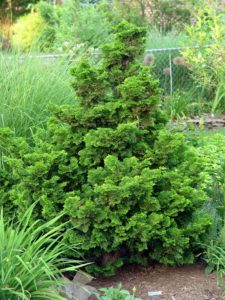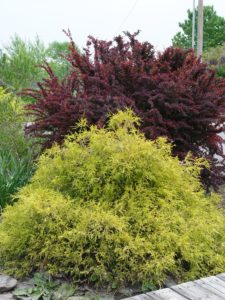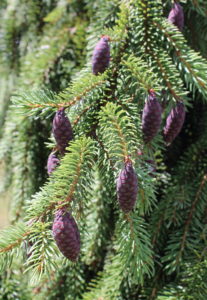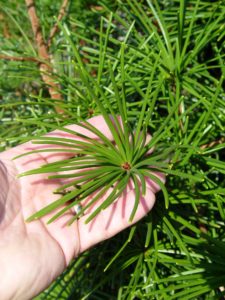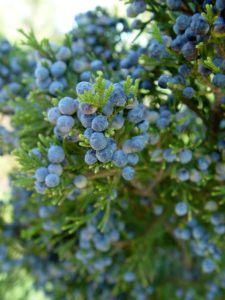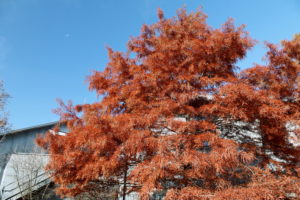12 of the Best Needled Evergreen Trees
A lot of needled evergreens can run into trouble of various sorts, from environmental woes like excess rain, poorly drained soil, and rising temperatures to species-specific attacks such as woolly adelgids on hemlocks, bagworms on arborvitae, spider mites on dwarf Alberta spruce, and the increasing incidence of needlecast diseases on Douglas firs and Colorado blue spruce.
The combination of good plant selection and proper siting (generally lots of sun and excellent soil drainage) can jack up your odds of success.
Here’s a list of 12 of my favorite needled trees (technically, favorite “conifers” since two of the choices are cone-bearers whose needles turn color and drop in winter).
1.) Hinoki cypress (Chamaecyparis obtusa)
These come in all sorts of sizes and shapes, from two- to three-foot globes to 18-foot uprights. Some varieties have golden needles.
Some of the most useful are the dwarf uprights ‘Nana Gracilis’ and ‘Gracilis Compacta,’ which grow slowly to six or eight feet tall and five to seven feet wide. Those are much better options than the mite-prone dwarf Alberta spruce.
Hinoki cypresses seldom run into any bug or disease troubles, deer don’t care for them, and they’ll take a fair amount of shade.
2.) Weeping Alaska-cedar (Xanthocyparis nootkatensis)
This is my favorite specimen conifer. The habit is fairly narrow and upright (25-by-10 feet in 20-25 years) with gracefully arching limbs and soft needles.
Not a true cedar, Alaska-cedar is extremely cold-hardy and rarely runs into any problems. ‘Green Arrow’ is a particularly skinny variety.
3.) Green-thread and gold-thread falsecypresses (Chamaecyparis pisifera)
The dwarf gold-threads are most popular (and useful) these days with varieties such as ‘Golden Mop’ and ‘Lemon Thread’ making excellent, colorful, textural, and bullet-proof landscape accents that grow four to six feet tall and slightly wider.
The needles are soft and “shaggy.” Standard types can grow upwards of 16 feet tall and 12 feet wide.
4.) Oriental spruce (Picea orientalis)
A little hard to find in garden centers, Oriental spruce seems to be more resistant to the needlecast diseases that are decimating blue spruce.
The dense habit, sleek pyramidal form, and glossy green needles make this one of the nicest specimen or screening conifers, even without counting the reddish-purple cones. Just keep it out of wet or salty soil.
Grows 40 to 50 feet tall and half as wide in 20-25 years.
5.) Serbian spruce (Picea omorika)
Similar in size and habit to Oriental spruce, Serbian spruce has lighter green needles with white streaking, giving the tree an almost bluish cast.
Also more disease-resistant than blue spruce, these have little purplish cones.
6.) Norway spruce (Picea abies)
Long used as a screening evergreen, Norway spruce is still one of the most widely available and reliable workhorses. Its branches take on a graceful sagging habit as the trees age.
Like almost all spruces, this one is struggling in the warming climate from Virginia south. In Zone 7 and cooler (central Pa. is mostly Zone 6b), we should be OK for decades. Figure on about 50 feet tall and half as wide in 20-25 years.
7.) ‘Green Giant’ arborvitae (Thuja plicata)
This particular arborvitae has fast become a top-seller for good reason… it’s a type of western arborvitae that deer don’t like nearly as much as our native eastern arborvitae.
‘Green Giant’ grows very fast to about 25 feet tall and eight feet wide in 20 years and will keep going from there, albeit at a slower rate.
It’s tolerant of some shade, usually grows with a single leader (making it less prone to splitting and splaying than older multi-leadered arbs), and seems to be less prone to bagworms than other arborvitae as well.
8.) Japanese umbrella pine (Sciadopitys verticillata)
Here’s a gorgeous and unusual conifer that most people have never seen but quickly notice once they do. The standout feature is the thick, almost succulent straw-like needles that are arranged umbrella-like around the stems.
Japanese umbrella pines aren’t completely abuse-free as they don’t like alkaline soils, need water in a drought more than most conifers, and have a fairly narrow climate range (we’re right in the middle, though, of their Zone 5 to 7 range).
They’re a little harder to find than some conifers and more expensive than most because of their slow growth habit. Given two or three decades, umbrella pines can grow 25 feet tall and 15 feet wide.
9.) Bosnian pine (Pinus heldreichii var. leucodermis)
Pines in general run into a lot of bug and disease issues. Bosnian pine, I’ve found, isn’t immune but at least is less likely to run into serious problems.
The three-inch needles are stiff and dark green, and the tree’s habit is dense and bushy. It’ll grow about 40 feet tall and 20 to 25 feet wide in 20-25 years.
10.) Eastern red cedar (Juniperus virginiana)
This native with the stiff, scaly needles comes in a lot of shapes and sizes, ranging from low and spreading creepers to narrow, upright trees that typically grow 20 to 25 feet tall and eight to 10 feet wide in 20-25 years.
Eastern red cedars (actually a juniper and not a true cedar) take much abuse, including extreme heat, extreme cold, drought, salt, wind, and lousy soil. They actually prefer alkaline soil. Just keep them out of soggy spots.
11.) Dawn redwood (Metasequoia glyptostroboides)
This ancient species, once thought to be extinct, looks like a needled evergreen but surprises plant rookies in fall when the needles turn a copper color and then drop. That’s because it’s a deciduous conifer – one that naturally loses all of its foliage each winter.
Dawn redwoods grow straight and solid, developing a muscular trunk that takes on a rusty color. The needles are soft, flat, and light to medium green, although there’s at least one golden-needled variety out there.
You’ll need a lot of space for this one since dawn redwoods can eventually grow up to 100 feet tall and 25 to 30 feet wide.
12.) Bald cypress (Taxodium distichum)
A second excellent deciduous conifer is this one, which is one of the few conifers that not only tolerates but prefers wet conditions.
Bald cypress is a native tree that also does reasonably well in dry soil, and it’s largely trouble-free and tough in both extreme heat and extreme cold.
The needles are soft and flat and turn a russet color in fall before dropping. Growth rate is fairly fast to about 50 feet tall and 25 feet wide in 20-25 years.








